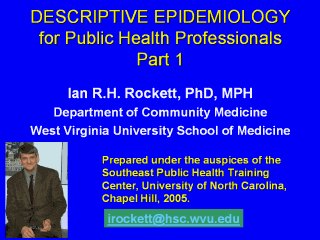| front |1 |2 |3 |4 |5 |6 |7
|8 |9 |10 |11 |12 |13 |14 |15 |16 |17 |18 |19 |20 |21 |22 |23 |24 |25 |26 |27 |28 |29 |30 |review |
 |
I am Ian Rockett, a
native of Australia and Professor of Epidemiology in the Department of
Community Medicine at West Virginia University. Before you move through this
module on descriptive epidemiology I would like to set the scene. The
initial target audience was public health professionals, but in the spirit
of the Supercourse I now seek to reach any audience who might find this
material of interest or use. There are various ways that we can differentiate epidemiology, which is the study of the distribution and determinants of disease, injury, and other health-related outcomes in populations – primarily, but not exclusively, human populations. One way we can differentiate epidemiology is by substantive outcome of interest, such as communicable disease, chronic disease, and injury. Another is by exposure focus, such as exercise, nutrition, or occupation. Yet another way is by level of analysis, as across the spectrum of micro-epidemiology, risk factor epidemiology, and macro-epidemiology, a journey that can take us from cellular and genetic investigation by bench scientists to the far reaches of our globe and into outer space. The most fundamental distinction that epidemiologists draw is between descriptive and analytic epidemiology. My aim is to familiarize you with the methods and materials of the descriptive domain within the middle ground of risk factor epidemiology, an area that employs many public health professionals in varying capacities. For ease of use, I have broken this module into four sections. Part 1 looks at gross changes in population and disease across time and space, and introduces you to the history of epidemiology. In Part 2, we shall look at some rudimentary models of disease and injury, and then shift to data sources. Part 3 is concerned with measurement and Part 4 highlights the questions that propel descriptive epidemiology, presents various descriptive research designs, and examines the bridge between descriptive and analytic epidemiology, namely, hypothesis formulation. I would like to acknowledge Janet Place, Director of the Southeast Public Health Training Center, for her support and encouragement regarding this project, and Aimee Bolen and Heather Lloyd for their assistance with graphics. |